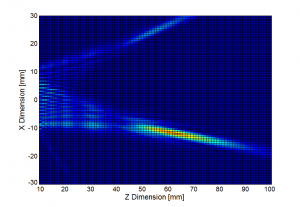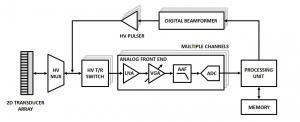Fully Electronic, Wearable Transcranial Doppler Ultrasonograph System
- Category: Circuits & Systems, Medical Electronics
- Tags: Charles Sodini, CICS, Hae-Seung Lee, Sabino Pietrangelo
Intracranial pressure (ICP) is a key factor in monitoring a patient’s cerebrovascular state. However, current ICP measurement modalities are highly invasive, relying on surgical penetration of the skull. Recent developments in model-based physiology allow ICP to be estimated using arterial blood pressure and cerebral blood flow velocity (CBFV) measurements [1] . CBFV can be obtained non-invasively using transcranial Doppler (TCD) ultrasonography, but requires bulky capital equipment and an expert operator to manually focus the ultrasound beam on a particular intracranial blood vessel. Therefore, TCD measurements of CBFV are currently restricted to clinical environments in which such technology and expertise are available (typically neurocritical care units).
This project seeks to develop a low-power, miniaturized TCD ultrasonography system for measuring CBFV in the middle cerebral artery (MCA) in support of continuous monitoring of ICP. The MCA is typically about 3 mm in diameter and is insonated through the temporal bony window at a distance of 40 to 60 mm from the ultrasonic transducer array. These anatomic considerations place significant constraints on the focal length and spatial resolution requirements of the transducer array. Adjusting the transmit amplitude and phase of each element in the 2D transducer array via a digital beamformer and high voltage (HV) pulser achieves electronic beam steering in three spatial dimensions. Figure 1 shows relative acoustic power density for a 15° off-axis focus using a 2D transducer array with electronic beam steering.
Development of a beam steering algorithm will allow for autonomous location of the MCA, eliminating the need for a skilled operator. TCD ultrasonography focusing is further complicated by the highly non-homogenous acoustic propagating medium (i.e., presence of high-density cranium). This issue can be mitigated, however, using calibration methods [2] . An HV multiplexer (MUX) is utilized so that a single transmit/receive (T/R) channel can connect to multiple transducer elements and thus greatly reduce the necessary electronics and power requirements. This system architecture, as illustrated in Figure 2, will allow for a self-contained system for continuous CBFV measurement in a low-power and wearable form-factor.
- Figure 1: Relative acoustic power density (in XZ plane) demonstrating beam steering for a 15° off-axis focus.
- Figure 2: Pulsed wave ultrasonography block diagram.
- F. M. Kashif, T. Heldt, and G. C. Verghese. “Model-based estimation of intracranial pressure and cerebrovascular autoregulation,” Computers in Cardiology, vol. 35, pp. 369-372, Sep. 2008. [↩]
- G.T. Clement and K. Hynynen, “A non-invasive method for focusing ultrasound through the human skull,” Physics in Medicine and Biology, vol. 47, pp. 1219-1236, Apr. 2002. [↩]

